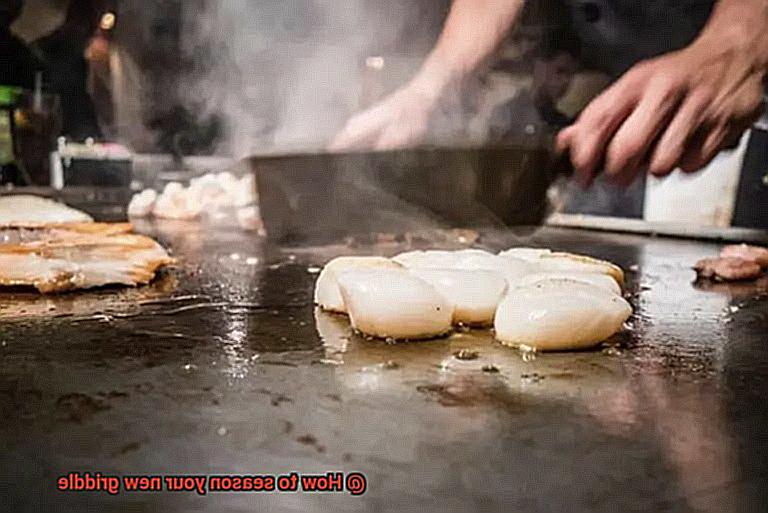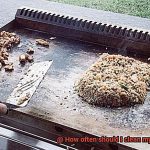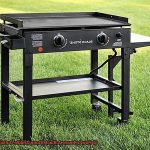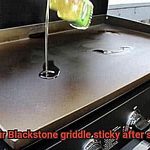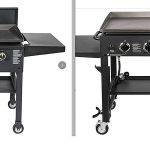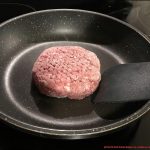Want to cook like a pro? Seasoning your griddle is the key. It may seem daunting, but it doesn’t have to be.
We’ll take you through the steps of how to season your new griddle so you can start enjoying hearty meals with ease. Cooking on an unseasoned griddle can be frustrating.
Food sticks and burns easily, making for time-consuming clean up. But seasoning your griddle is fast and simple – just minutes of effort for delicious results.
You’ll turn your griddle into a non-stick surface that will make cooking simpler and more enjoyable. We’ll start by discussing why seasoning is important.
Then we’ll move onto the steps involved in seasoning your griddle. Plus, we’ll have advice on how to maintain a seasoned surface over time and how to tell when it’s time to re-season your griddle.
You’ll have all the details you need to season your new griddle like a pro by the end of this blog post.
Contents
Cleaning the Griddle Before Seasoning
If you’re looking for a perfect griddle, the first step is to prepare it before using it.
Seasoning your griddle creates a non-stick coating that prevents rusting and ensures delicious pancakes every time. But before you can season your griddle, it’s essential to clean it thoroughly.
Cleaning your griddle is an important part of the seasoning process because it removes any factory residue, dirt, or debris that may be on the surface. This residue can affect the seasoning process and hinder the non-stick properties of the griddle.
Start by scrubbing the griddle surface with soap and water. Take care not to scratch the surface or damage the griddle while scrubbing.
You can also use a scraper or spatula to remove any stubborn particles or stains from your surfaces. Afterwards, rinse the griddle surface with water and dry it off with a towel.
To make sure all oils and impurities are removed from the surface, you can also use vinegar or a commercial degreaser. Remember to avoid abrasive cleaners if your griddle has a non-stick coating to prevent damage.
Taking time to clean your griddle properly before seasoning will help you achieve a better and longer-lasting seasoning layer as well as keeping unwanted flavors or particles from contaminating your food.
Choosing the Right Oil for Seasoning
Seasoning your griddle is an essential step in creating a non-stick cooking surface and preventing rust.
To achieve the best results, you must use the right oil for the job. While vegetable oil is often used for seasoning, it may not be the most suitable option due to its low smoke point.
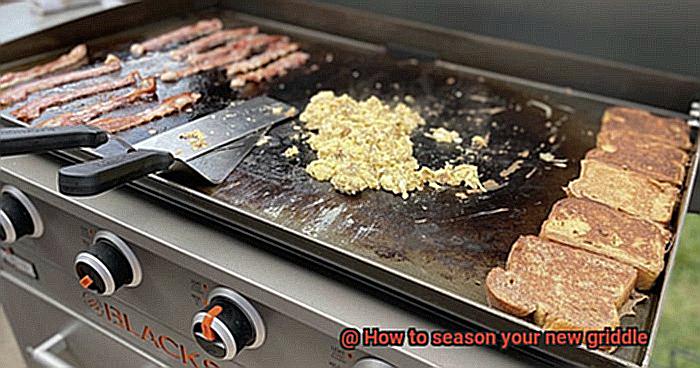
Flaxseed oil, however, has a higher smoke point and contains omega-3 fatty acids, making it an ideal choice for creating a durable and non-stick seasoning layer. When prepping to season your griddle, make sure to apply a thin layer of oil over the entire surface with a paper towel or cloth.
Then heat up your griddle to a high temperature so that the oil can set and bond with the metal. You may need to repeat this process multiple times until you have achieved a good seasoning layer.
Applying the Oil to the Griddle Surface
Applying the oil is an essential step in achieving a non-stick surface that will last.
When selecting your oil, it’s important to choose one with a high smoke point. Neutral oils like canola, vegetable, or grapeseed oil are best for this purpose as they won’t burn quickly and create a sticky residue.
Avoid using butter or olive oil as they have low smoke points and won’t give you the desired results. Once you’ve picked your oil, pour some onto the griddle’s surface and use a clean cloth or paper towel to spread it evenly over all corners and edges.
Then turn up the heat to medium-high and let it cook for 20-30 minutes until it begins to smoke – this indicates that the seasoning process is in progress. When it’s done, allow it to cool before wiping off any excess with a clean cloth or paper towel.
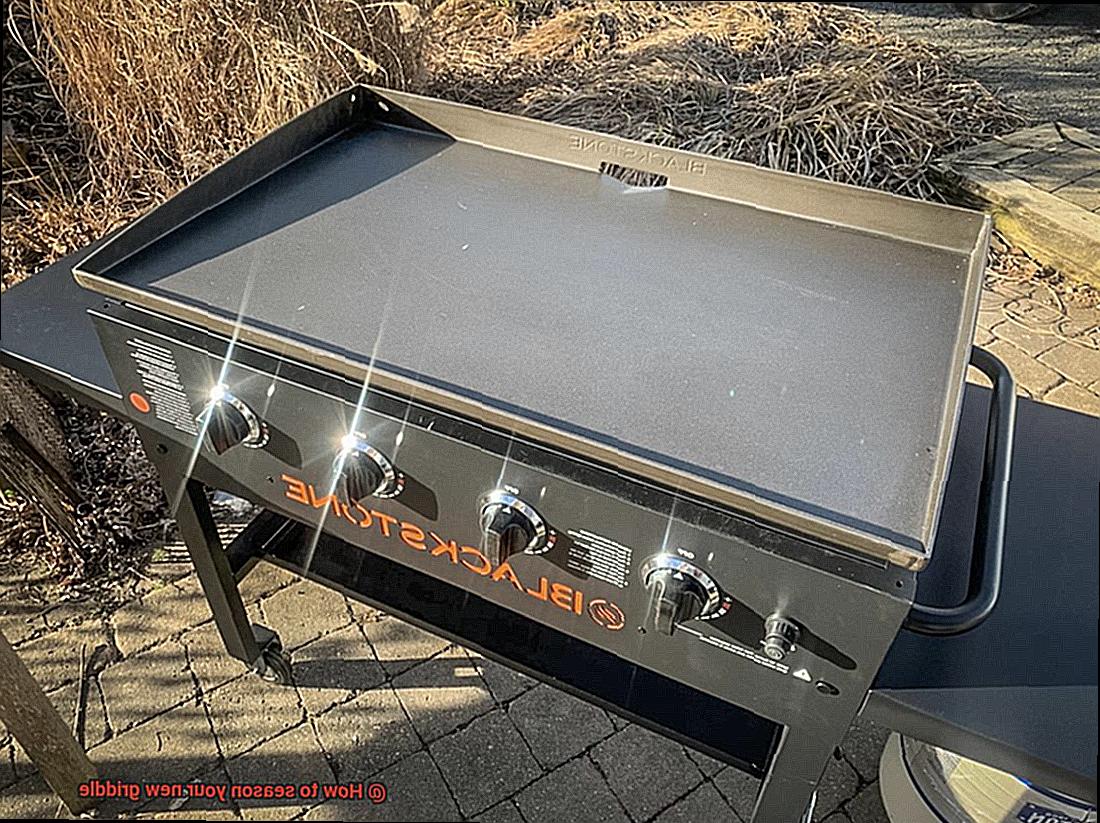
Seasoning your griddle with oil is easy and will help ensure that your griddle works well and lasts longer.
Heating the Griddle to Create a Protective Layer
Seasoning your griddle is an essential step in achieving a non-stick cooking surface and preventing rusting.
By coating the griddle with oil and then heating it up, you create a protective layer that will ensure you have many delicious meals ahead. But why is this process so important?
Essentially, the heat helps to bond the oil with the griddle’s surface, resulting in a non-stick finish. Think of it as baking a cake: you’ll need to combine all the ingredients together and then bake it in the oven for it to come out perfect.
The same goes for seasoning your griddle; you’ll need to oil coat it and then heat it up for the perfect finish. To get started, begin by cleaning your griddle with warm water and soap, then completely dry it off.
Utilizing either a paper towel or cloth, apply a thin layer of oil over the entire cooking surface. Once complete, turn on your griddle to high heat and let it run for around 10 to 15 minutes before reducing the heat to medium setting and allowing it to continue heating up for an additional 10-15 minutes.
It’s important not to cook anything on your griddle during this seasoning process as doing so will damage the protective layer that you’re trying to create.
Ventilating the Area During Heating Process
When it comes to seasoning your griddle, it is essential to ensure proper ventilation during the heating process.
As the griddle is heated, it will release smoke, fumes, and carbon monoxide which can be hazardous if inhaled in large amounts. To ensure safety and a successful cooking experience, it is recommended to season your griddle in an outdoor area or a well-ventilated space.
Avoid seasoning indoors, especially in small or confined spaces as the smoke and fumes can quickly build up and become dangerous. To further protect yourself from any harm, turn on a fan or open windows and doors to allow fresh air to circulate.
Additionally, keep children and pets away from the area while seasoning your griddle to prevent any accidents or injuries.
Repeating the Process Until Desired Results are Achieved
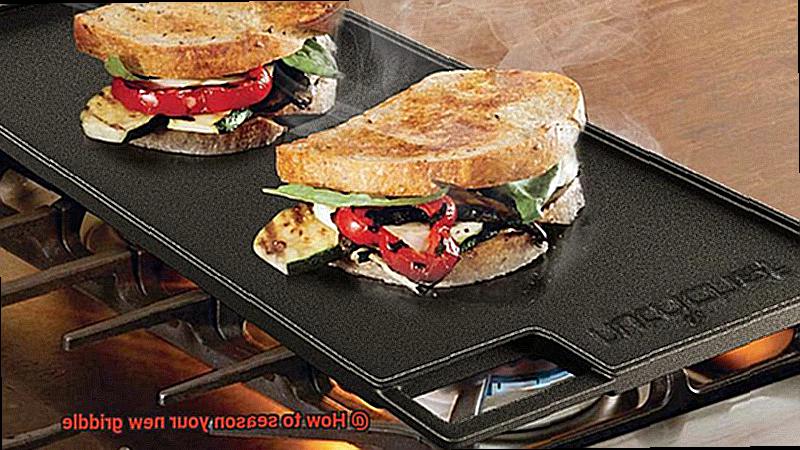
Achieving the best results when seasoning your new griddle requires patience and consistency.
You’ll need to repeat the process of cleaning and applying oil until you are satisfied with the results. Think of it like training a puppy; in order for the process to be successful, you need to be consistent and patient.
You’ll have to clean and oil your griddle multiple times until it is fully seasoned and ready for use. It’s also important to note that after each use, you should sanitize your griddle and apply a light coating of oil to maintain its freshness.
Doing this will help ensure that your griddle stays in good condition, providing you with delicious meals for years to come.
VspmDVnj2pI” >
Maintaining Regular Seasoning Intervals
Keeping your griddle in good condition requires regular care and attention, just like caring for a beloved pet.
Seasoning is a key step in this process, as it creates a protective layer on the surface, preventing rust and creating an even non-stick cooking surface. The frequency of seasoning depends on how often you use the griddle.
It’s recommended to apply a thin layer of oil after each use, known as “spot seasoning,” to keep the coating intact. For more thorough care, it’s necessary to do a deep seasoning every few months or so, depending on usage.
This process helps preserve the quality of your griddle’s surface and prevents sticking or flaking.
Also Read: Can You Season a Blackstone Griddle With Bacon Grease
Conclusion
Seasoning your griddle is the key to a non-stick cooking surface and delicious meals.
With the right oil, proper ventilation, and regular care, you can season like a pro. Start by using a neutral oil with a high smoke point such as flaxseed or canola oil.
Heat your griddle to medium-high temperatures for 20-30 minutes until it begins to smoke. You may need to repeat this process several times before you have achieved the desired seasoning layer.
To keep your griddle fresh, sanitize it regularly and apply a thin layer of oil after each use. This will ensure that your griddle is in top condition and provides you with tasty meals for years to come.
Seasoning your griddle will not only improve the quality of food but make clean-up much simpler too.

